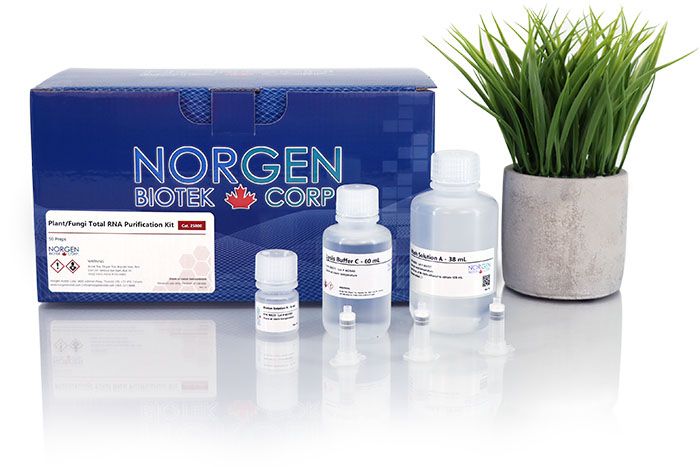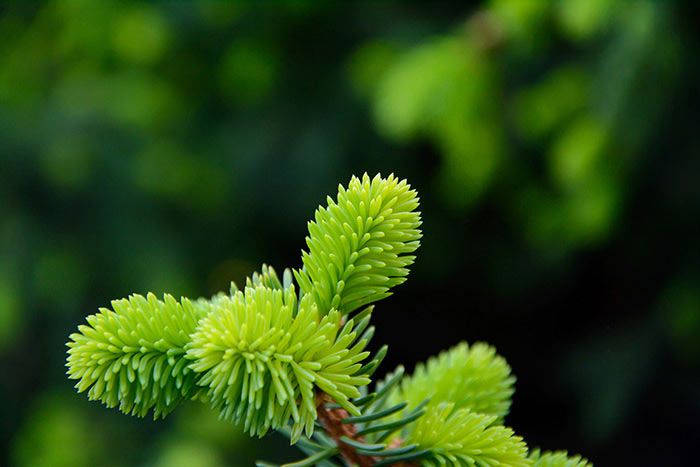Plant/Fungi Total RNA Purification Kit
For the rapid purification of total RNA (including microRNA) from plants and fungi
For research use only and NOT intended for in vitro diagnostics.
For the rapid purification of total RNA (including microRNA) from plants and fungi





For research use only and NOT intended for in vitro diagnostics.
For the rapid purification of total RNA (including microRNA) from plants and fungi
Register today to receive an exclusive 15% off* on your first order.
Norgen’s Plant/Fungi Total RNA Purification Kit provides a rapid method for the isolation and purification of total RNA, including virus and viroid RNA, from a wide range of plants. Total RNA can be purified from fresh or frozen plant tissues, plant cells or filamentous fungi samples using this kit. All sizes of RNA are purified, including microRNA (miRNA) . The procedure is rapid and convenient.
The RNA is purified without the use of phenol or chloroform. The purified RNA is of the highest quality, and can be used in a number of downstream applications including real time PCR, reverse transcription PCR, Northern blotting, RNase protection and primer extension, and expression array assays.
Norgen's Plant/Fungi Total RNA Purification Kit is also available in a 96-well (High Throughput) format for high throughput applications. Purification with the 96-well plates can be performed using either a vacuum manifold or centrifugation.
Figure 1. Isolation of High Quality RNA, even from Difficult Samples. Total RNA was isolated from 50 mg samples of apple (Lanes 1), peach (Lanes 2), grape (Lanes 3), pine needle (Lanes 4), strawberry (Lanes 5) and pear (Lanes 6) using Norgen's kit and a competitors kit. Five microlitres of total RNA from the 50 µL elution was loaded on 1X MOPS 1.0 % Formaldehyde-Agarose RNA gel for analysis. Norgen's kit allowed for the isolation of high quality RNA from all the samples, including the difficult samples, while the competitor failed to isolate RNA from grape, pine needles and strawberry. Furthermore, only Norgen's kit was able to isolate the small RNA species (white box).
Figure 2. Detection of EF1-α using one step RT-qPCR from Challenging Plant Samples. Total RNA was isolated from 50 mg samples of apple (red), peach (green), pine needle (blue) and grape leaves (burgundy) using Norgen's Plant/Fungi Total RNA Purification Kit. Three µL of the eluted 50 µL of RNA was used in an RT-qPCR reaction for the detection of EF1-α. EF1-α was detected from all samples, indicating that the RNA is of high quality and that the Plant/Fungi RNA Purification kit is highly sensitive for total RNA isolation.
Figure 3. High Yield of Plant RNA Samples isolated from Apple, Peach and Pear. Total RNA was isolated using Norgen's kit (Blue bars) and a competitor’s kit (Dark blue bars) from 50 mg of apple, peach and pear according to the provided manual. In each case the RNA was eluted into 50 µL. RNA yield was measured by spectrophotometer in triplicate, and the average concentration was used for data analysis. Norgen's kit resulted in higher yields of total RNA, including miRNA. Total processing time was less with Norgen's kit than competitor's kit.
Figure 4. High Purity of RNA Samples Isolated from Apple, Peach and Pear. RNA was isolated from 50 mg samples of apple, peach and pear using Norgen's Plant/Fungi RNA Purification Kit and a competitor's kit. RNA purity was determined spectrophotometrically for the RNA isolated using Norgen's kit (260/230 = dark blue bars) and the competitor's kit (260/230 = light blue bars). Also shown is the 260/280 ratio for the samples. Norgen's kit consistently isolated pure samples of Plant RNA with 260/230 ratios above 2.0, whereas the competitor's kit had 260/230 ratios below 1.2 for the same samples.
|
Kit Specifications - Spin Column
|
|
|
Maximum Column Binding Capacity
|
50 μg
|
|
Maximum Column Loading Volume
|
650 μL
|
|
Size of RNA Purified
|
All sizes, including small RNA (< 200 nt) |
| Maximum Amount of Starting Material: Plant Tissues Plant Cells Fungi |
50 mg 1 x 106 cells 50 mg (wet weight) |
| Average Yield* 50 mg Tomato Leaves 50 mg Tobacco Leaves 50 mg Plum Leaves 50 mg Grape Leaves 50 mg Peach Leaves |
60 μg 60 μg 32 μg 35 μg 30 μg |
| Time to Complete 10 Purifications |
30 minutes
|
* Yield will vary depending on the type of sample processed.
* Yield will vary depending on the type of sample processed.
Storage Conditions and Product Stability
All solutions should be kept tightly sealed and stored at room temperature. This kit is stable for 2 years after the date of shipment.
Tobacco (Nicotiana tabacum)
Tomato (Lycopersicon esculentum)
Pepper (Capsicum annuum)
Potato (Solanum tuberosum)
Arabidopsis thaliana1
Peach (Prunus persica)
Apple (Malus sp.)
Pear (Pyrus sp.)
Grape vine (Vitis sp.)
Plum (Prunus sp.)
Palm (Arecaceae)
Pine needle (Pinaceae)
Strawberry
Raspberry
Blackberry
Herbs
Persimmon (Ebenaceae)
Potato tuber (Solanum)
Plum fruit
Citrus
Vanilla bean
Cotton (Gossypium)
Mangrove
Chrysanthemum
Grape berry skin
Kiwi leaves
Peach (fruits and flowers)
Soy bean (legume)
Eastern White Red Cedar
Corn leaves
Cucumber leaves
| Component | Cat. 25800 (50 preps) | Cat. 31350 (100 preps) | Cat. 25850 (250 preps) | Cat. 31900 (192 preps) |
|---|---|---|---|---|
| Lysis Buffer C | 60 mL | 1 x 30 mL, 1 x 60 mL | 3 x 60 mL | 2 x 60 mL |
| Wash Solution A | 38 mL | 38 mL | 1 x 18 mL, 2 x 38 mL | 2 x 38 mL |
| Elution Solution A | 6 mL | 6 mL | 20 mL | 20 mL |
| Filter Columns | 50 | 100 | 250 | - |
| Spin Columns | 50 | 100 | 250 | - |
| 96-Well Plate | - | - | - | 2 |
| Adhesive Tape | - | - | - | 4 |
| Collection Tubes | 100 | 200 | 500 | - |
| 96-Well Collection Plate | - | - | - | 2 |
| Elution Tubes (1.7 mL) | 50 | 100 | 250 | - |
| 96-Well Elution Plate | - | - | - | 2 |
| Product Insert | 1 | 1 | 1 | 1 |
Poor RNA recovery could be due to one or more of the following:
Do not exceed the recommended amounts of starting materials. The amount of starting material may need to be decreased if the column shows clogging below the recommended levels. See also “Clogged Column”.
It is recommended that the Elution Solution A supplied with this kit be used for maximum RNA recovery.
Ensure that the appropriate amount of ethanol is added to the lysate before binding to the column.
Ensure that the indicated amount of 96 - 100% ethanol is added to the supplied Wash Solution A prior to use.
Different tissues and cells have different RNA contents, and thus the expected yield of RNA will vary greatly from these different sources. Please check literature to determine the expected RNA content of your starting material.
Clogging can result from one or a combination of the following factors:
Ensure that the appropriate amount of lysis buffer was used for the amount of cells or tissue.
The optimal input of plant tissue or filamentous fungi has been provided for each kit under Kit specifications, and also in the product insert.
Ensure that most cell debris is removed in Step 1c in the protocol.
When using a high-throughput kit with a vacuum manifold, ensure that a vacuum pressure of at least -650 mbar or -25 in Hg is developed.
Ensure that the centrifuge remains at room temperature throughout the procedure. Temperatures below 20°C may cause precipitates to form that can cause the columns/wells to clog.
If the RNA does not perform well in downstream applications, it may be due to one or more of the following:
Traces of salt from the binding step may remain in the sample if the well is not washed 3 times with Wash Solution A. Salt may interfere with downstream applications, and thus must be washed from the well.
Ensure that the dry spin under Column Wash in the centrifugation protocol or the extended vacuum in the vacuum protocol is performed in order to remove traces of ethanol prior to elution. Ethanol is known to interfere with many downstream applications.
These kits can process multiple plant tissues including but not limited to the following:
Yes, these kits are capable of purifying dsRNA as well.
Yes, this kit is able to process freeze-dried leaves.
| Title | Complete Genome Characterization of Penicillimonavirus gammaplasmoparae, a Bipartite Member of the Family Mymonaviridae |
| Citation | Plants 2023. |
| Authors | Félix Morán , Antonio Olmos ,Thierry Candresse and Ana Belén Ruiz-García |
| Title | Bridging the gap: parallel profiling of ribosome associated and total RNA species can identify transcriptional regulatory mechanisms of plants in spaceflight |
| Citation | Journal of Plant Interactions 2023. |
| Authors | Eric S. Land, Emma Canaday, Alezander Meyers, Sarah Wyatt & Imara Y. Perera |
| Title | Spatiotemporal patterns of wheat response to Pyrenophora tritici-repentis in asymptomatic regions revealed by transcriptomic and X-ray fluorescence microscopy analyses |
| Citation | Journal of Experimental Botany 2023. |
| Authors | Paula Moolhuijzen, Lilian M V P Sanglard, David J Paterson, Sean Gray, Karina Khambatta, Mark J Hackett, Ayalsew Zerihun, Mark R Gibberd and Fatima Naim |
| Title | A Novel and Highly Inclusive Quantitative Real-Time RT-PCR Method for the Broad and Efficient Detection of Grapevine Leafroll-Associated Virus 1 |
| Citation | Plants 2023. |
| Authors | Félix Morán, Antonio Olmos, Miroslav Glasa, Marilia Bueno Da Silva, Varvara Maliogka, Thierry Wetzel and Ana Belén Ruiz-Garcia |
| Title | Cooperation and Coexpression: How coexpression networks shift in response to multiple mutualists |
| Citation | Molecular Ecology 2018. |
| Authors | Palakurty, S. X., Stinchcombe, J. R., & Afkhami, M. E. (2018). |
| Title | Selection of suitable reference genes for quantitative real-time PCR gene expression analysis in Salix matsudana under different abiotic stresses |
| Citation | Scientific Reports 2017. |
| Authors | Zhang, Y., Han, X., Chen, S., Zheng, L., He, X., Liu, M., ... & Zhuo, R |
| Title | Occurrence of hypovirus-infected Cryphonectria parasitica isolates in northern Spain: an encouraging situation for biological control of chestnut blight in Asturian forests |
| Citation | European Journal of Plant Pathology 2017. |
| Authors | Trapiello, E., Rigling, D., & González, A. J |
| Title | Analysis of Extracellular Vesicles Produced in the Biofilm by the Dimorphic Yeast Pichia fermentans |
| Citation | Journal of Cellular Physiology 2017. |
| Authors | Leone, F., Bellani, L., Mucciflora, S., Giorgetti, L., Bongioanni, P., Simili, M., ... & Del Carratore, R. |
| Title | Overexpression of quinone reductase from Salix matsudana Koidz enhances salt tolerance in transgenic Arabidopsis thaliana |
| Citation | Gene 2016. |
| Authors | X Song, J Fang, X Han, X He, M Liu, J Hu, R Zhuo |
| Title | The Arabidopsis Transcription Factor ANAC032 Represses Anthocyanin Biosynthesis in Response to High Sucrose and Oxidative and Abiotic Stresses |
| Citation | Frontiers in Plant Science 2016. |
| Authors | Mahmood, K., Xu, Z., El-Kereamy, A., Casaretto, J. A., & Rothstein, S. J |